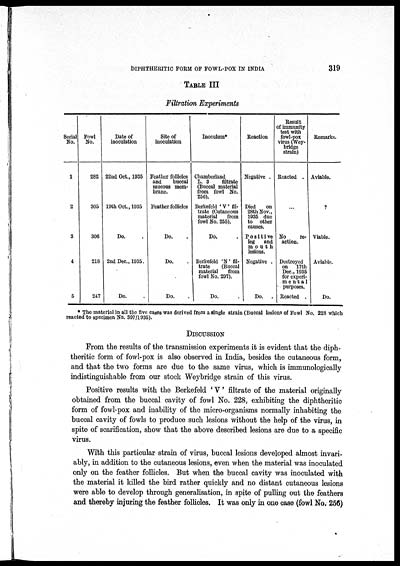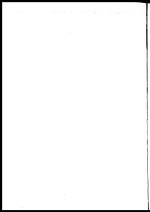Medicine - Veterinary > Veterinary colleges and laboratories > Indian journal of veterinary science and animal husbandry > Volume 6, 1936 > Articles > Studies on the diphtheritic form of fowl-pox in India
(372) Page 319
Download files
Individual page:
Thumbnail gallery: Grid view | List view

DIPHTHERITlC FORM OF FOWL-POX IN INDIA 319
TABLE III
Filtration Experiments
|
Serial |
Fowl |
Date of |
Site of |
Inoculum |
Reaction |
Result |
Remarks. |
|
1 |
282 |
22nd Oct., 1935 |
Feather follicles |
Chamberland |
Negative . |
Reacted . |
Aviable. |
|
2 |
305 |
19th Oct., 1935 |
Feather follicles |
Berkefeld ' V ' fil- |
Died on |
. . . |
? |
|
3 |
306 |
Do. . |
Do. . |
Do. . |
P o s i t i ve |
No re- |
Viable. |
|
4 |
218 |
2nd Dec, 1935. |
Do. . |
Berkefeld 'N' fil- |
Negative . |
Destroyed |
Aviable. |
|
5 |
247 |
Do. . |
DO. . |
Do. . |
Do. . |
Reacted . |
Do. |
* The material in all the five cases was derived from a single strain (Buccal lesions of Fowl No. 228 which
reacted to specimen No. 397/1935).
DISCUSSION
From the results of the transmission experiments it is evident that the diph-
theritic form of fowl-pox is also observed in India, besides the cutaneous form,
and that the two forms are due to the same virus, which is immunologically
indistinguishable from our stock Weybridge strain of this virus.
Positive results with the Berkefeld ' V' filtrate of the material originally
obtained from the buccal cavity of fowl No. 228, exhibiting the diphtheritic
form of fowl-pox and inability of the micro-organisms normally inhabiting the
buccal cavity of fowls to produce such lesions without the help of the virus, in
spite of scarification, show that the above described lesions are due to a specific
virus.
With this particular strain of virus, buccal lesions developed almost invari-
ably, in addition to the cutaneous lesions, even when the material was inoculated
only on the feather follicles. But when the buccal cavity was inoculated with
the material it killed the bird rather quickly and no distant cutaneous lesions
were able to develop through generalisation, in spite of pulling out the feathers
and thereby injuring the feather follicles. It was only in one case (fowl No. 256)
Set display mode to: Large image | Zoom image | Transcription
Images and transcriptions on this page, including medium image downloads, may be used under the Creative Commons Attribution 4.0 International Licence unless otherwise stated. ![]()
| Permanent URL | https://digital.nls.uk/75238657 |
|---|
| Description | Covers articles from 1936. |
|---|




